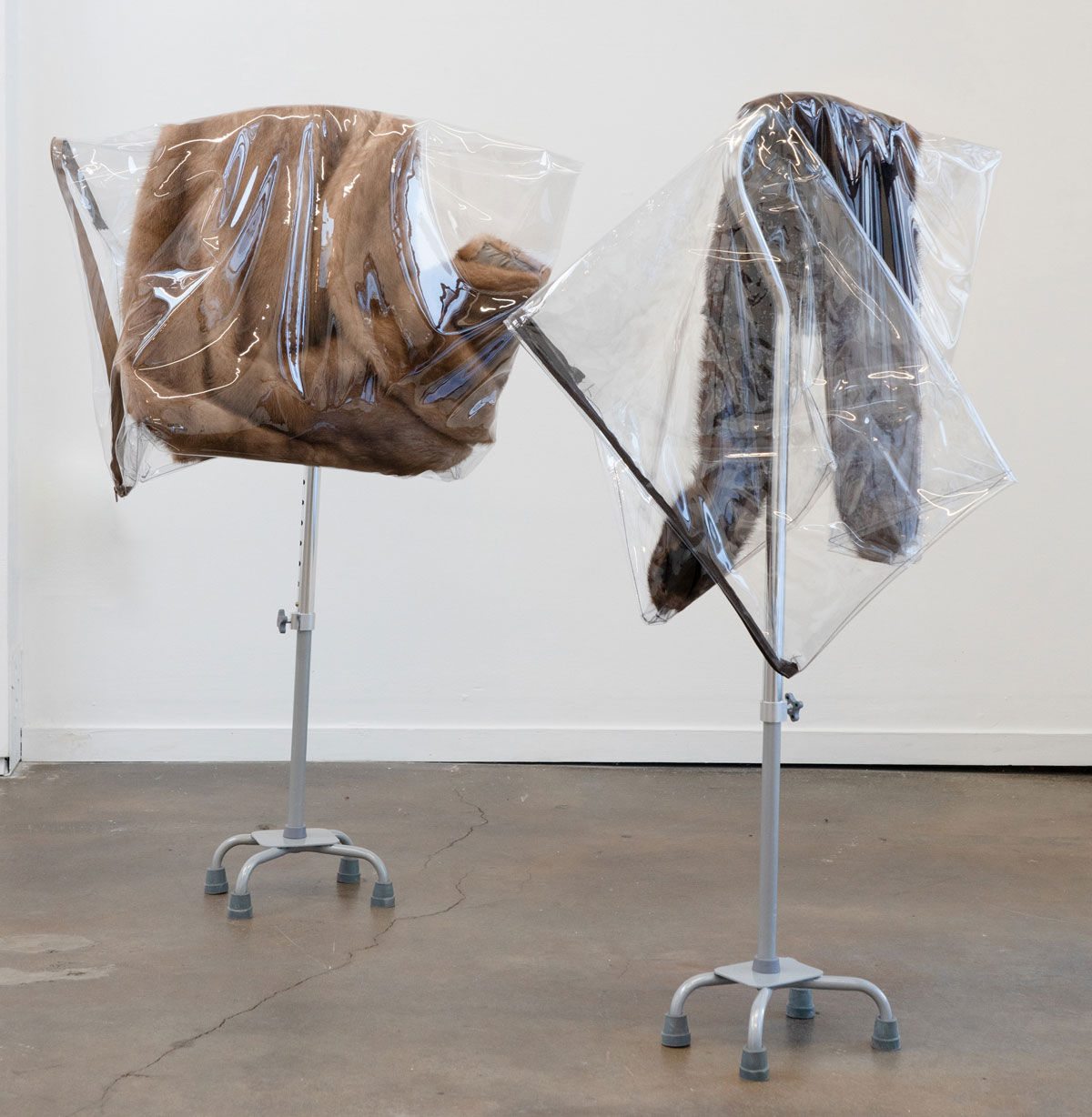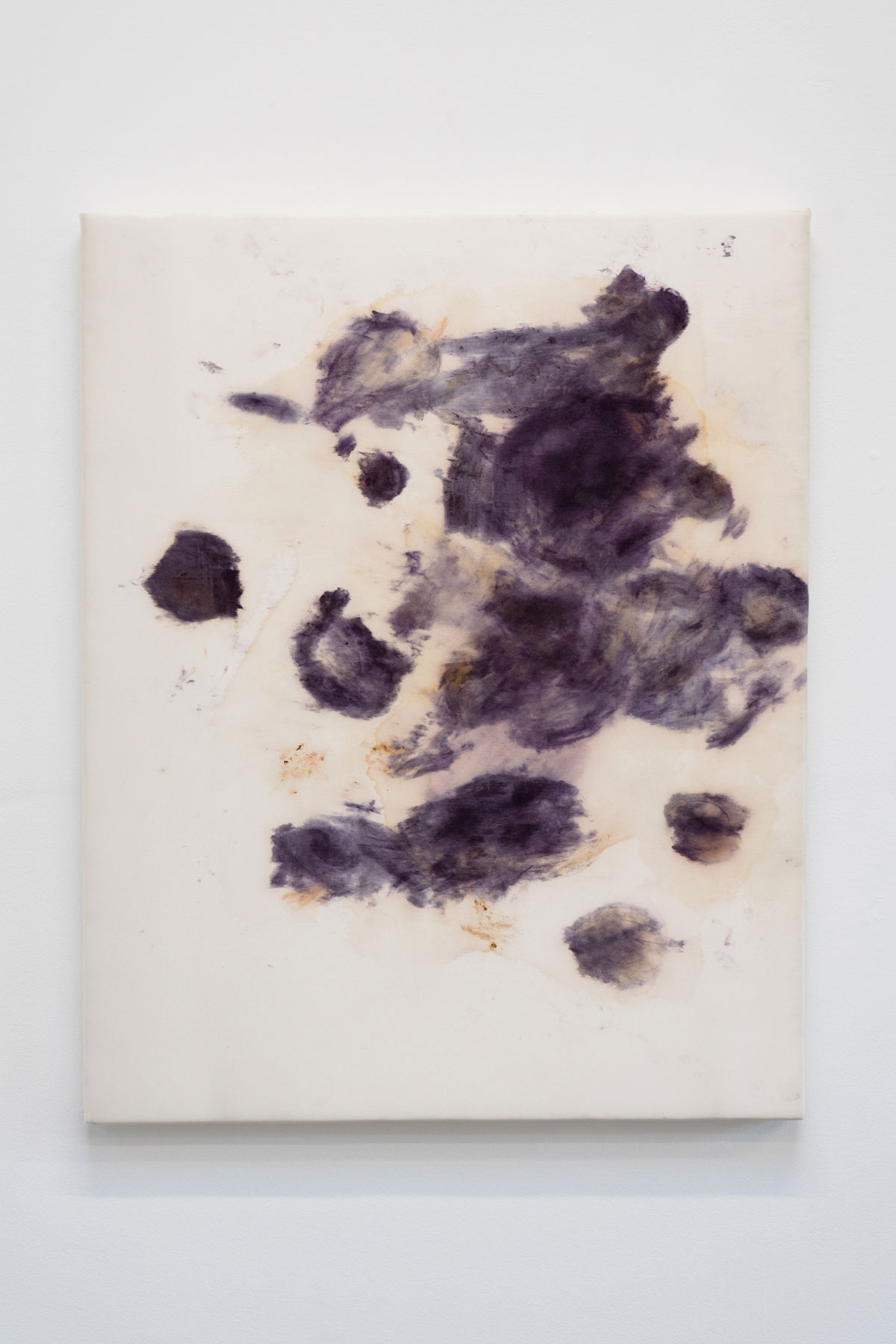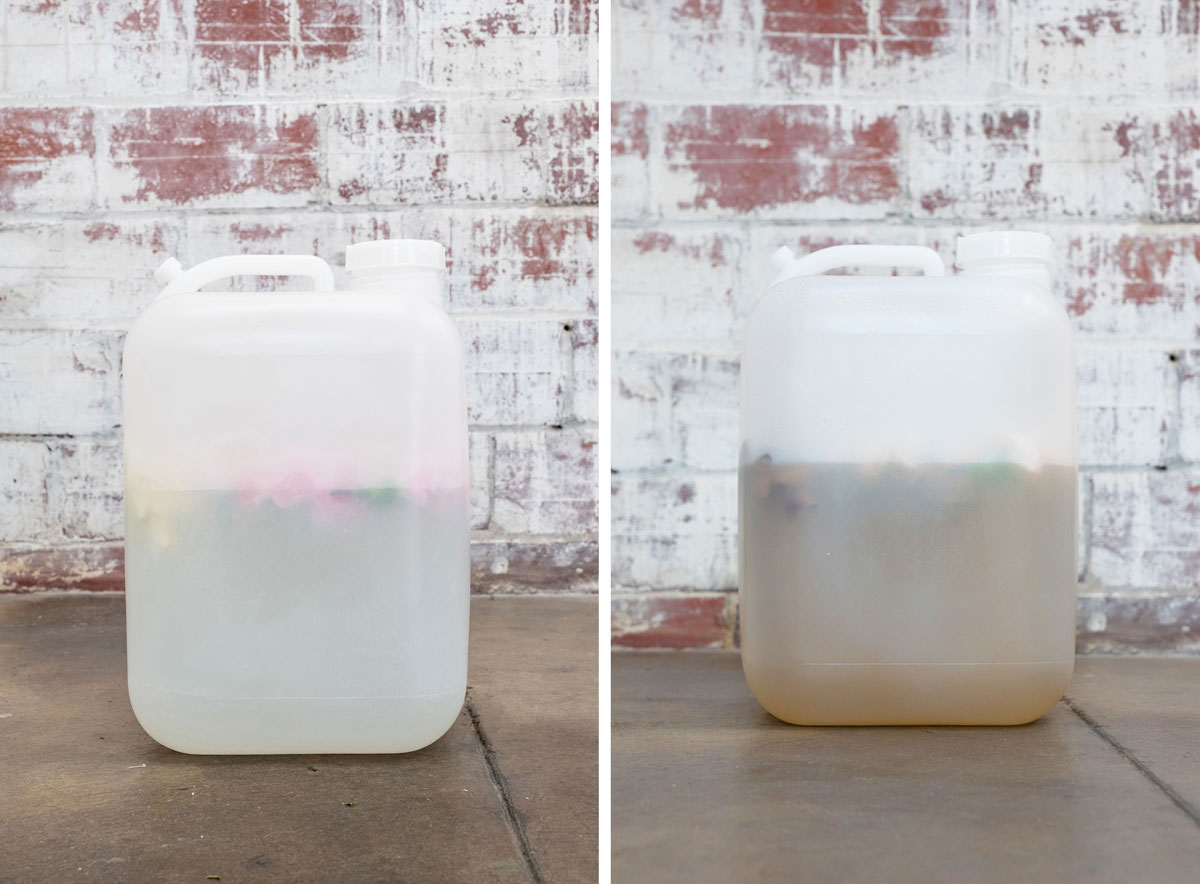“Art imitates life,” goes the old adage; and Quay Quinn Wolf’s art in his solo show, Pink Velvet Dress with the Fur Collar, is a rejoinder to the film Imitation of Life. Douglas Sirk’s 1959 adaptation of Fannie Hurst’s novel of the same name becomes the vehicle for Wolf’s meditation on race, ephemerality and the body. The film is one that the New York City-born and based artist watched with his grandmother as a child, and the show contains blended allusions to the film and her commentary.
The five pieces currently on view in Oakland’s Interface Gallery, are evocative in their own right, but are animated anew by a complementary viewing of the movie. It’s a masterful thematic marriage of sculpture and film, never relying too heavily on cinematic reference in a way that alienates audiences unfamiliar with it. The show is like a rabbit hole: you can delve as deeply into its themes as you would like or are able, and as you plunge deeper and deeper, Wolf’s work becomes more and more emotionally fraught.
Wolf’s fur and velvet pieces, all draped over metal stands, are as reminiscent of standing human figures as they are imbued with symbolic meaning. Two furs, separately titled Dreaming of Luxury, are wrapped in zippered PVC bags, citing the protective covers for upholstery (a familiar part of many black domestic landscapes) and the rarity of the furs themselves. The sparse, white and whitewashed brick-walled gallery feels paradoxically austere in the presence of these wealth-indicating fabrics. Fur is far more commonly associated with white old money than any artistic consideration of black life.

But in a recent New York Times essay, Jasmine Sanders parallels fastidious caring for fur as an extension of black wearers’ own bodies. “My mother likens caring for the coats to the attention her own mane requires,” she writes. The impulse to protect material items reflects the desire to preserve, to cling to permanence of matter that will inevitably rot and degrade. It reflects a desire to pass down items as well as the psychology of pride that they contain (Sanders also writes: “My mother’s furs are her insistence on public elegance in a world frequently inhospitable to her”), as well as a classed anxiety about commodity damage. The wealthy can replace easily, but the poor cannot.
The two furs on display, a vintage mink collar and a vintage mink fur stole, are folded, bagged and mounted atop walking canes as though to mimic storage or casual home display. They suggest mortality of both the commodity and whomever might be so lucky to elegantly adorn themselves with such attire. They also suggest, in their color, brown flesh, which differs from the wounded flesh of the pink velvet in the show’s centerpiece: I adored that velvet dress.
Imitation of Life is a story about a black domestic worker, Annie Johnson (Juanita Moore), and her white-passing daughter, Sarah Jane (Susan Kohner); I adored that velvet dress recalls Wolf’s grandmother’s response to one of the dresses worn by the film’s main white character, Lora Meredith (Lana Turner). The delicate-looking pink velvet fabric is stained with African red roses (many of which come from a growing rose belt in Kenya) and shea oil (a staple of black skin care regiments). But this glamorous velvet, mounted on a taller chrome C-stand, seems to loom over the furs like a colorist embodiment of the beautiful fair-skinned daughter who might pass for white, a woman desperately wishing to transcend her muddy genes.

The decorative staining of the luxurious item is not unlike the staining on the wall-mounted cream silk canvas, I am white, I’m as white as Susie!, clearly meant to simulate a bruise—they are both created using African roses and shea oil. The piece is named for Sarah Jane’s indignant retort to her mother’s despairing realization that she had been passing for white at her school. It is an emotional and psychological bruising. In the film, the mother wonders how to tell her daughter she was “born to be hurt.” In the film, Sarah Jane’s white boyfriend beats her in the street upon discovering she is black, asking, humiliated, if it’s true that her mother is black—in his anger, he uses the analogous anti-black slur.
In a “post-racial” present where websites still shock and amuse us with lists of celebrities “you wouldn’t guess are actually black,” we might forget passing is not simply a description of proximity to white phenotypicality: it is a phenomenon with stakes. What is contemporarily novel—the revelation of one’s black parentage and ancestry—was once met with punishment.
Annie Johnson says her daughter was born to be hurt in no small part because she also was born to be hurt. Partus sequitur ventrum (Latin for “that which is brought forth follows the womb”) is the legal doctrine that codified blackness, and servitude, as genetic. If a mother was a slave, her daughter would also be a slave no matter the identity of her father. It is upon this marker of literally bruised brown flesh and metaphysically wounded flesh that Wolf sharply sets his visual-conceptual stage, as well as the entire tricky interplay between maternal care and sacrifice, the devastation of filial denial and refusal, and embrace.
The relative emptiness of the room offers valuable space for the audience to maneuver, which Wolf has cleverly exploited in the arrangement of his pieces. The brown gradient furs are clustered in the corner while the pink velvet occupies the center, like a beacon for and warning against naïve attempts to overcome blackness. At the right angle, the two iterations of mottled, marred flesh align, the physical and ontological assaults speaking to one another. At another angle, black harm and black repair also hold conversation.

In one of the film’s last moments, Sarah Jane runs through the street and throws herself onto her mother’s casket. The death of the mother she loved deeply and constantly sought to escape forces a reconciliation of her long-denied identity and an acknowledgement of her mother’s sacrifice. There is no better representation of this climactic moment than Wolf’s use of organic material in the show’s final piece.
Soon I will be done, trouble of the world is a five-gallon plastic jug filled with water, gardenias and pink carnations. Wolf’s mother studied mortuary science, her work with death informed by black church rites—at Annie’s funeral, gospel legend Mahalia Jackson delivers a devastating rendition of “Trouble of the World.” Wolf previously honored his mother in his 2018 show, Arrangements, and he nods to his inherited knowledge of funerary ritual with his choice of florals in Pink Velvet Dress.
In the origin myth of the pink carnation, they bloomed where the Virgin Mary’s tears landed on the earth: they are a symbol of the purest and most eternal motherly love (as experienced by Wolf and as embodied by Annie). Over the course of the show, as the flowers have died and decayed, the water in the jug has turned from clear to brown. While harm and mortality are motifs in Wolf’s work, so too are celebrations of comfort, healing and nostalgia.
In considering the relationships between care work and gendered black labor, it bears noting that Juanita Moore, the actress who plays Annie Johnson, received an Oscar nomination for Best Supporting Actress at a time when Hattie McDaniel was the only black actor to have won an Oscar (not coincidentally for her role as “Mammy” in Gone with the Wind, setting an unfortunate precedent for the limited honoring and casting of black women’s roles in film).
Anti-blackness often ensures remembrances only in death. But Wolf provides a layered affective framework for iterative memory and remembrance: one that does not shy away from acknowledgements of mortality and temporality, but one that emphasizes a nourishment of bonds with and care for the living as much as we do our ancestral dead.

‘Pink Velvet Dress with the Fur Collar’ is on view at Interface Gallery through Sept. 29. Details here.